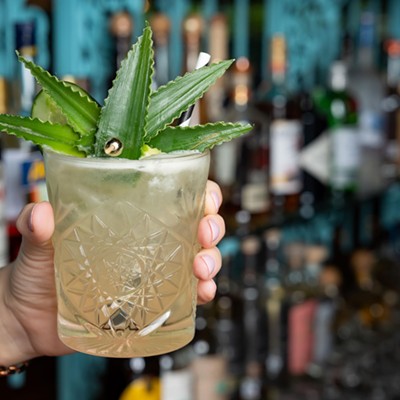My wife tends to order scattershot, practically leaping from apps to dessert without missing a beat, skipping back over for a salad or a misplaced side. SaltAir Seafood Kitchen, the new-ish temple of seafood from the Clark/Cooper group and helmed by executive chef Brandi Key, is perfect for her. On one visit, our waiter followed her erratic ordering without missing a beat, cobbling a coherent meal from our meanderings. The menu itself encourages this sort of hunt-and-peck meal planning, studiously avoiding strict designations (or even loose ones, really) and encouraging variety.
Sketched out with a rough hashing of hasty lines and a casual script, it looks like a brainstorming session — the sort of stream-of-consciousness document you might expect from a chef in the early stages of menu planning. It’s charming, even if a bit confounding, and the food it represents is as well thought out as the menu is casually disarrayed.
Of course, that casual approach has its own perils, as on another night, when our hopscotch order was met with an odd question from our waiter: “How hungry are you?” We asked if he thought we’d ordered enough food; the menu doesn’t always give clear direction on portion sizes, and he might have been looking out for us. As it turned out, he simply wanted to scrap standard course order, sending food out “as the kitchen has it ready.”
Unfortunately, the kitchen took that to mean a plate of clam fries with sauce gribiche, ordered to round out the redfish half-shell we’d opted to split, came out with the Bibb salad and before the hamachi crudo we’d intended as opening salvo. Of course, we didn’t have to wait long on the crudo, which arrived about four bites into the salad. That left me deciding whether to allow the salad or crudo to warm, or the clam fries to cool. Certainly not ideal.
Now that the minor quibbles are out of the way, though, we can focus on the fact that that Bibb salad was serious stuff. Giant, pearly lumps of crab, sweet and delicate but with a pleasantly firm edge. A Thousand Island dressing equal parts zippy and suave, edged up by a judicious squeeze of lemon. Greens resting perfectly in the crux between gentle crispness and velvety tenderness. The quartered hard-boiled eggs were a bit over, ringed with an off-putting gray, but the tomato was admirably rosy despite the chill in the air.
The crudo was nearly perfect, wanting only, perhaps, a bit more acid and a few flakes of good salt. Still, the fish fairly popped under-tooth like so many delicate sacks of plump citrus. Cubes of crisp, barely sweet Asian pear lent structure, repeated in harmony by a different, more insistent crisp from fried shallots. The herbal twinge of torn Thai basil perfumed every third or fourth bite. A punchy onion purée added a nicely gentle allium spark, even if its texture read a bit juvenile. One of many interactive items on the menu, the presentation encourages experimentation, scooping different bits from the stylized ring with each bite. Here some saline sweet fish might come through more, then the sweet crispness of Asian pear, buttressed by savory and deeply flavored shallot crisps, complementary and contrasting flavors and textures pinging off each other, faltering only when a bite occasionally listed too sweet. We didn’t even mind that we never could seem to isolate the foie gras listed on the menu, checklist-style.
You’ll want to fully explore the chilled and raw seafood section of the menu, which proves consistently excellent. I can hardly imagine a meal at SaltAir commencing without half a dozen oysters, shucked more skillfully than you might find elsewhere. They come with a well-tuned mignonette, bumped up a key with Thai chiles and ginger, but I found myself eschewing the stuff, the better to appreciate the cold, briny sweetness of the bivalves and their well-preserved liquor.
Perhaps a couple of Lucky Limes from Prince Edward Island, plump and earthy with herbal notes. Or Piper Points, also PEI specimens, delicate little guys, clean-tasting and super-salty like the essence of ocean. If you’re going to use the mignonette, these would be the ones. If you want something richer, Isle Dauphine from Alabama, slender wisps, are briny but buttery and deep. I’ve rarely had better oysters. Pair them with a glass of Franciacorta, a dense, rich sparkler with a nice yeasty bloom and subtle perfume, served in a generous coupe.
While Key’s skill with raw seafood might not surprise, the varied and valuable array of vegetable dishes that fill a good portion of the regular menu certainly do. Roasted carrots swathed with harissa read meaty and dense, the spice recalling chorizo and playing up the vegetal sweetness nicely, even as the roots veer into meaty main dish territory. Radishes come three ways: roasted whole, raw and still boasting tender roots and leaves, shaved into thin and peppery coins. Four, if you count the radish green pesto, turning the single-minded dish into a kaleidoscope of textures and flavors, painting radishes in a different light than you’re likely to have seen previously. Asparagus gets the faintest of kisses from the grill, left blessedly crunchy and green-tasting, its snap reinforced with a gently acidic tumble of orange segments punctuated by a scattering of chives. The section is broad and inviting, so much so that you may be tempted to skip the mains entirely. Don’t do that.
The regular menu offers only a handful of entrée-type dishes; most of the party is going down on the daily specials, chalked in above the pass (and handed out on a separate slip of paper at your table). The whole fish seems to be a firm fixture, though variety changes. Be sure to ask your waiter about not only weight and price, but count. A slightly confusing exchange left us with two one-pound vermilion snappers, after the recommendation of a two-pound order by our waiter. Had we known the format in which those two pounds would arrive, we might have opted for one, leaving room to explore other parts of the menu as well. Of course, that might have left us fighting over the fish, especially its skin in all its salty, crispy glory. Moist and flaky, clean and simple, it was almost a shame to augment it. Then, we discovered the nuoc cham. Its vinegar tang, mild chile bloom, savory backbone and gentle sweetness proved a perfect foil for the fish. Almost every bite was dragged through the stuff.
Likewise, the redfish on the half-shell warrants serious consideration. A technique not often seen these days, and rarer yet in such a casually luxe setting, it’s a near perfect way to cook fish. The filet is left with its skin and scales, tossed directly on the grill fully dressed. Its suit protects the skin, while the charring outerwear gently perfumes the meat with smoke. The torpedo-shaped fish is plenty for two, and generous at that. Gently slip the provided utensils between the fish and its skin, and free the succulent meat. It would be a lovely touch if the wait staff provided the service, especially for the uninitiated.
Once you’ve freed your portion, you’ll be rewarded with the spicy herbal punch of chermoula and Moroccan spices, which seem ready transplants for Houston’s dining proclivities. The dense, meaty fish pulls apart in fat, flaky chunks, practically gushing. Alongside, a smooth, understated couscous tabbouleh both reinforces the herbal flavors on the fish and cools its slight fire with both its cool temperature and its cooling mint. It’s carefully considered cooking, simple in execution and complex in flavor. That’s also true of a skewer of grilled shrimp, presented almost ascetically, proudly proclaiming that they need be nothing more than what they are. WYSIWYG, in its most delicious form, just the barest edge of Aleppo pepper duskiness and sumac tart to kick up the char from the grill. They could, perhaps, have been pulled a scant few moments sooner, turning a bit meatier, a bit less supple. Barely noticeable, on the whole.
Across my visits, only a few dishes completely failed to deliver. One, the tempura. It looked lovely, and the texture was a thrill. Unfortunately, the mix of cauliflower, green and yellow squash and shiso leaves tasted mostly of grease. The desserts are a true oddity, tending toward the baroque where so much of the menu is focused almost to the point of appearing sparse.
Despite the oddly jumpy menu, eating well at SaltAir is surprisingly simple. Follow the menu’s lead and let your eye wander. Pick some wine from the well-priced menu, order something cold and raw to start, maybe a salad, then move on to vegetables. You can hardly go wrong there. Mind the specials, and keep it simple. That’s what SaltAir does best, and it does that exceptionally well.
SaltAir Seafood Kitchen
3029 Kirby, 713-521-3333, saltairhouston.com. Hours: 5 to 9 p.m. Sundays, 5 to 10 p.m. Mondays through Thursdays, 5 to 11 p.m. Fridays and Saturdays.
Hamachi crudo $16
Crab Louie (Bibb salad) $16
Clam fries $10
Grilled shrimp $13
Tempura $10
Redfish half-shell Market Price
Carrots $9
Radish $7
Asparagus $8
Whole vermilion snapper Market Price
Half-dozen oysters Market Price
Support Us
Houston's independent source of
local news and culture
account
- Welcome,
Insider - Login
- My Account
- My Newsletters
- Contribute
- Contact Us
- Sign out
Eating Well at SaltAir Seafood Kitchen Is Surprisingly Simple
Nicholas L. Hall December 15, 2015 6:00AM
[
{
"name": "Related Stories / Support Us Combo",
"component": "11591218",
"insertPoint": "4",
"requiredCountToDisplay": "4"
},{
"name": "Air - Billboard - Inline Content",
"component": "11591214",
"insertPoint": "2/3",
"requiredCountToDisplay": "7"
},{
"name": "R1 - Beta - Mobile Only",
"component": "12287027",
"insertPoint": "8",
"requiredCountToDisplay": "8"
},{
"name": "Air - MediumRectangle - Inline Content - Mobile Display Size 2",
"component": "11591215",
"insertPoint": "12",
"requiredCountToDisplay": "12"
},{
"name": "Air - MediumRectangle - Inline Content - Mobile Display Size 2",
"component": "11591215",
"insertPoint": "4th",
"startingPoint": "16",
"requiredCountToDisplay": "12"
}
,{
"name": "RevContent - In Article",
"component": "12527128",
"insertPoint": "3/5",
"requiredCountToDisplay": "5"
}
]
KEEP THE HOUSTON PRESS FREE...
Since we started the Houston Press, it has been defined as the free, independent voice of Houston, and we'd like to keep it that way. With local media under siege, it's more important than ever for us to rally support behind funding our local journalism. You can help by participating in our "I Support" program, allowing us to keep offering readers access to our incisive coverage of local news, food and culture with no paywalls.
Nicholas L. Hall is a husband and father who earns his keep playing a video game that controls the U.S. power grid. He also writes for the Houston Press about food, booze and music, in an attempt to keep the demons at bay. When he's not busy keeping your lights on, he can usually be found making various messes in the kitchen, with apologies to his wife.
Contact:
Nicholas L. Hall
Trending Food & Drink
- Feeding Houston: Brighter Bites, Houston Food Bank and Cougar Cupboard
- Upcoming Houston Food Events: JŪN Hosts a Pastry Pop-Up and Wine & Dine
- Houston Restaurants and Bars Celebrating 4/20 with Cannabis Cocktails, Munchies and More
-
Sponsored Content From: [%sponsoredBy%]
[%title%]

Don't Miss Out
SIGN UP for the latest
food & drink
news, free stuff and more!
Become a member to support the independent voice of Houston
and help keep the future of the Houston Press FREE
Use of this website constitutes acceptance of our
terms of use,
our cookies policy, and our
privacy policy
The Houston Press may earn a portion of sales from products & services purchased through links on our site from our
affiliate partners.
©2024
Houston Press, LP. All rights reserved.





